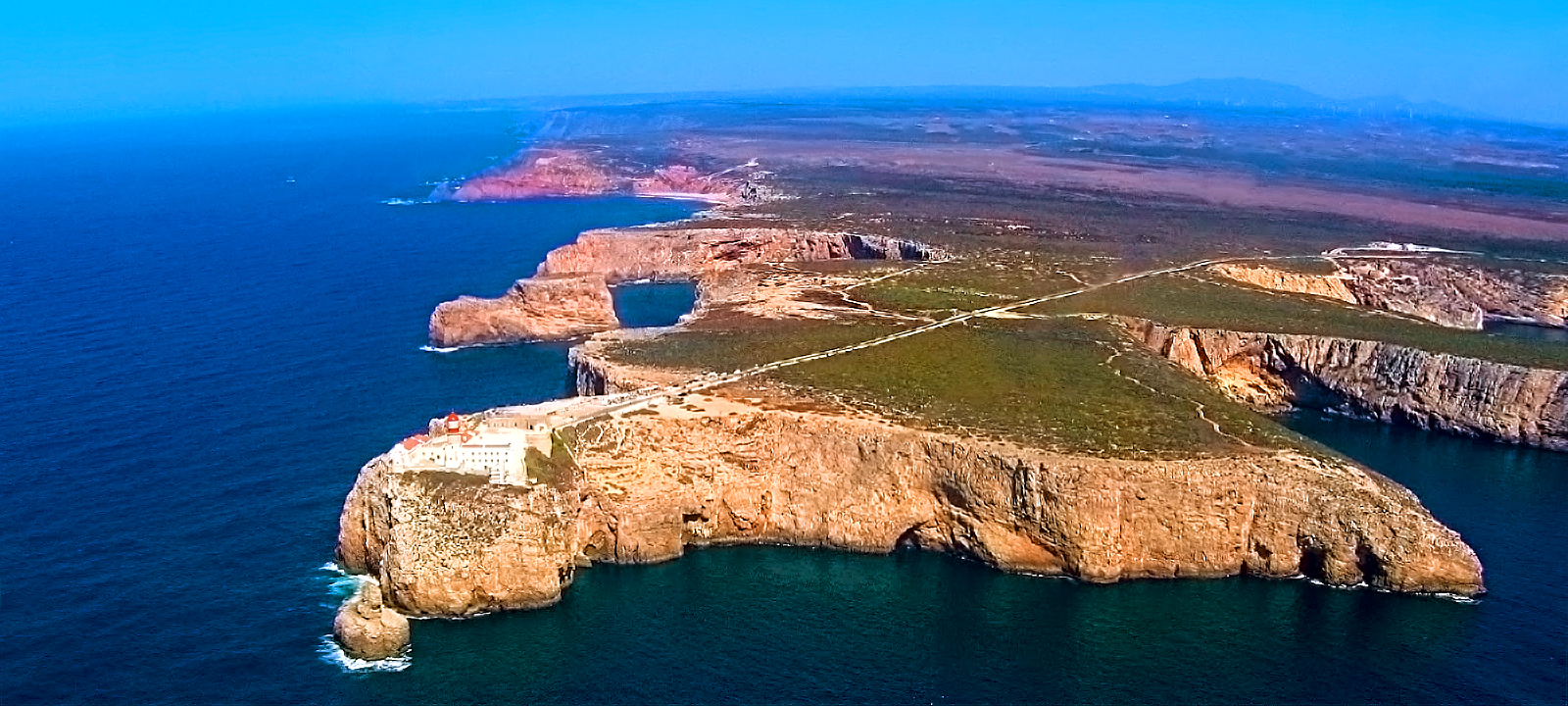
Being the most south-westerly point in mainland Europe, this rugged and forbidding Cape has long been considered sacred ground – ancient Greeks called it the ‘Land of Serpents’, but the pugnacious Romans oddly preferred a meeker designation: Promontorium Sacrum (‘Holy Promontory’), the Latin origin of the name ‘Sagres’ (from Sacrum). For them, terra firma-loving citizens of Rome, Cape St. Vincent was the ‘Edge of the World’, a supernatural vortex where the setting sun was dramatically submerged by the immense, unknown ocean (still today, the fading solar disk occasionally seems bigger and brighter at Cape St. Vincent). The myth persisted throughout the Middle Ages until a man decided to end all that crazy nonsense and – in the process – put an end to the Age of Darkness: Prince Henry the Navigator (1394 – 1460). Aerial Image Above: A Terceira Dimensão
The astronomically lucrative spice trade between Europe and the Far East was dominated by Arab merchants and their über-rich Venetian allies. “Why not bypass the infidel middlemen, locate Prester John, expand Christianity and humiliate the Muslim enemy?”, Henry thought. The way to achieve those ambitious goals, he realized, was to send heavily armed flotillas into the perilous Atlantic in order to chart ‘New Worlds’ and new oceanic routes to fabulous India. It was a giant leap of faith because nobody knew for sure whether the Earth was round or flat, or even if there was a feasible sea route into the mysterious Far East. Such purpose demanded new technologies, great fortitude, and a lot of brainpower. But this far-sighted venture paid off in spades. In 1498, almost 40 years after Henry’s death, Vasco da Gama finally landed in Calicut, India. The fates of East and West, India, China and Japan, Africa and Europe, started to diverge that same year. Portugal became the forerunner in the Age of Discovery. In its wake, scrambling for pepper and nutmeg, followed the Dutch, the Spanish, the British, the French…
As the supreme mastermind, Henry assembled the best astronomers-astrologers, mathematicians, naval architects and (the most intrepid or downright foolish) sailors he could find. Some say The Navigator founded a nautical school in Sagres but in fact Henry’s opus was a bit more like a true scientific institute – the first of its kind in the World – and it allegedly functioned where Sagres Fortress now stands. A giant compass rose within the Fortress seems to corroborate that assumption. However, nobody knows for certain. Why?
Because at 9:40 a.m. local time, the first day of November 1755, Earth’s crust suddenly unleashed a colossal amount of energy, creating the strongest earthquake and the highest tsunamis ever witnessed in European history. The hugely destructive 1755 Lisbon Earthquake razed the Algarvian cities to the ground – including Sagres – and annihilated cosmopolitan Lisbon, the capital of the Portuguese Empire, together with nautical charts, historical records, and technical documents. A part of Portuguese history was wiped out during an otherwise quite historic Saturday morning. The event aggravated political faults within the Kingdom of Portugal and utterly disrupted the country’s colonial purposes. Due to the earthquake, Portugal gradually lost its global influence. Despite its name, the epicentre of this massive quake was not in Lisbon. The real culprit?
Saint Vincent’s Fault, located about 180 km southwest of Cape St. Vincent. In the vicinity where all the glory started to take shape, all the aspirations started to crumble. Yet, effulgent grandeur and abrupt changes of fortune were nothing new to the Cape. A real playground of empires, between 1337 and 1833 the watery surface off St. Vincent witnessed no less than nine major naval combats. A staggering total by any account, this average number of almost two great military clashes per century accurately reflects the strategic importance of the Cape. Eight battles and a naval action bear the label ‘Cape St. Vincent’, be it to the Portuguese, to the Spanish, to the Dutch, to the Algerian, to the French, to the German (Brandenburg) or to the British. These same British would produce the other great mastermind whose naval actions are forever linked to Cape St. Vincent.
During the French Revolutionary Wars, the Kingdom of Spain declared war on the opposing Anglo-Portuguese long-held alliance. Suddenly, the British position in southern Europe came under mortal threat: how to access the Mediterranean if the Spaniards and French were blocking its entrance with no less than 38 ships of the line? Just slightly worried about battling French and Foe with only 15 ships, Sir John Jervis (later, Earl St. Vincent) proceeded to break enemy lines. It was the 14th day of February, 1797. Under his authority, there was a perennially seasick Commodore mastering a small 74-gun ship named HMS Captain.
Disobeying orders, the seasick, soon-to-be famous 39 years-old Horatio Nelson, decided to engage three much larger rival ships. One of them (the 130-gun Santísima Trinidad) was the heaviest-armed vessel in the World. After a protracted hour-long fight, Nelson captured two of the three larger enemy ships while inflicting heavy damage on the huge Santísima Trinidad. Looming over the horizon, the Cape witnessed as another rising star contributed decisively to yet one more brilliant outcome.
Nowadays, the most brilliant thing at Cape St. Vincent is the Portuguese Navy’s St. Vincent Lighthouse. Safeguarding one of the world’s most hectic shipping lanes, it hurls a powerful white beam 60 km into the dark expanse of the Atlantic Ocean. It is the second most powerful lighthouse in Europe after Phare du Creach, in Brittanny. You cannot visit St. Vincent’s Lighthouse, unfortunately. But you might observe awe-inducing sunsets, as well as the annual gatherings of Griffon and Egyptian vultures, thousands of them – and we bet that there will be some vigilant ravens patrolling the immense skies nearby…just in case.